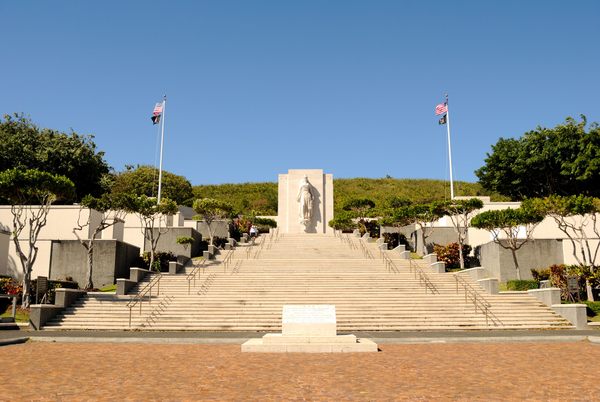Even before World War II, proposals had been made to build a military cemetery in Hawaii, but the need for such a cemetery became more pressing after the devastating loss of life during the war. An extinct volcanic crater located inland from downtown Honolulu was chosen as the site for the National Memorial Cemetery of the Pacific. The crater’s original name was Puowaina, but had picked up the nickname ‘Punchbowl’ since the arrival of missionaries in the islands.
Construction on the cemetery started in 1948, with the cemetery opening to the public in 1949. While the cemetery would be expanded several times over the years, the main focus of the cemetery has been the Honolulu Memorial, which was constructed in 1966 opposite to the cemetery’s entrance.
The center of the memorial features a statue of Lady Columbia standing at a top of long flight of stairs, with the inscription “The solemn pride that must be yours to have laid so costly a sacrifice upon the altar of freedom” written on the wall underneath statue. Flanking the statue are galleries with maps showing the various battles fought by the U.S. military during World War II as well as maps of the Korean War. Several courts flanking the staircase list soldiers reported as missing from engagements during World War II, the Korean War, and the Vietnam War.
Most of the rest of the cemetery contains simple flat rectangular granite grave markers for the individuals interred within the cemetery, with some additional memorial courts located along the periphery of the crater’s interior.
Many notable individuals, especially people with connections to Hawaii, have been buried within the cemetery, including Daniel K. Inouye, who served as Hawaii’s senator for over 50 years but who also lost his arm fighting in Italy in World War II; Ernest Pyle, a war correspondent who was shot while reporting from the Pacific; Norman Keith Collins (aka Sailor Jerry), who popularized tattoo art in the mid-twentieth century; and Ellison Onizuka, who was the first astronaut from Hawaii and who died on the space shuttle Challenger in 1986.
Even though the cemetery is a very solemn place, it also features a lookout built on the side closest to the ocean (or the “makai” side) of the crater with very good views of the area around the Hawaii State Capitol and the Downtown Honolulu areas but also has vistas towards Waikiki and Diamond Head as well. The cemetery has also made appearances in the many movies and television shows that have been filmed in Hawaii. Most notably, the cemetery appears in the pilot episode for the original Hawaii Five-O television series (as well as very briefly in the opening credits for the rest of the show’s run on television) and is featured in the newer Hawaii Five-O television series as the place where lead character Steve McGarrett’s father is buried.

